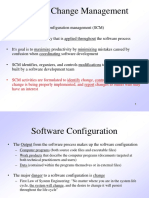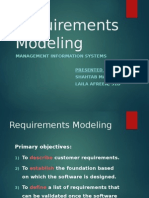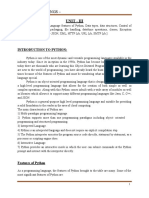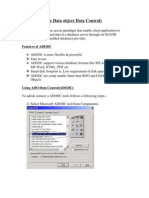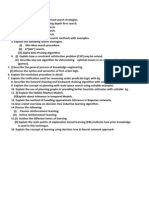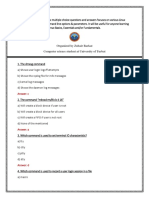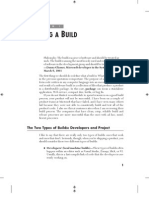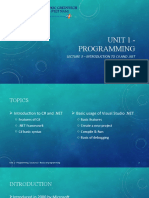Net Binaries
Net Binaries
Uploaded by
Saurabh GuptaCopyright:
Available Formats
Net Binaries
Net Binaries
Uploaded by
Saurabh GuptaCopyright
Available Formats
Share this document
Did you find this document useful?
Is this content inappropriate?
Copyright:
Available Formats
Net Binaries
Net Binaries
Uploaded by
Saurabh GuptaCopyright:
Available Formats
.net binaries A .NET PE is a PE just like the others.
It has an MZ header, a DOS segment, a PE header, a section table and sections: .text, .reloc, .rsrc. So far, everything is normal. A "typical" Windows binary contains all of these things, only the sections vary , depending on the compiler and language. The .text table contains an import table that imports one single DLL, mscoree.dll, and one single function, _CorExeMain. It also contains the .NET section: data about how your program works (classes, methods, etc), metadata and IL. So what happens when you start a .NET binary? Nothing really fancy. It simply works just like a "typical" Windows binary. It calls upon mscoree.dll to create a .NET runtime, that will load the .NET section of your executable. That runtime knows how to execute IL.
Metadata Metadata is binary information describing your program that is stored either in a common language runtime portable executable (PE) file or in memory. When you compile your code into a PE file, metadata is inserted into one portion of the file, while your code is converted to Microsoft intermediate language (MSIL) and inserted into another portion of the file. Every type and member defined and referenced in a module or assembly is described within metadata. When code is executed, the runtime loads metadata into memory and references it to discover information about your code's classes, members, inheritance, and so on. Metadata describes every type and member defined in your code in a language-neutral manner. Metadata stores the following information:
Description of the assembly. Identity (name, version, culture, public key). The types that are exported. Other assemblies that this assembly depends on. Security permissions needed to run. Description of types. Name, visibility, base class, and interfaces implemented. Members (methods, fields, properties, events, nested types). Attributes. Additional descriptive elements that modify types and members.
Benefits of Metadata Metadata is the key to a simpler programming model, eliminating the need for Interface Definition Language (IDL) files, header files, or any external method of component reference. Metadata allows .NET languages to describe themselves automatically in a language-neutral manner, unseen by both the developer and the user. Additionally, metadata is extensible through the use of attributes. Metadata provides the following major benefits:
Self-describing files. Common language runtime modules and assemblies are self-describing. A module's metadata contains everything needed to interact with another module. Metadata automatically provides the functionality of IDL in COM, allowing you to use one file for both definition and implementation. Runtime modules and assemblies do not even require registration with the operating system. As a result, the descriptions used by the runtime always reflect the actual code in your compiled file, which increases application reliability.
Language interoperability and easier component-based design. Metadata provides all the information required about compiled code for you to inherit a class from a PE file written in a different language. You can create an instance of any class written in any managed language (any language that targets the common language runtime) without worrying about explicit marshaling or using custom interoperability code.
Attributes. The .NET Framework allows you to declare specific kinds of metadata, called attributes, in your compiled file. Attributes can be found throughout the .NET Framework and are used to control in more detail how your program behaves at run time. Additionally, you can emit your own custom metadata into .NET Framework files through user-defined custom attributes.
.net types and .net name spaces isual Basic type Boolean Byte Char Date Common language runtime type structure Nominal storage allocation 2 bytes 1 byte 2 bytes 8 bytes Value range
System.Boolean System.Byte System.Char System.DateTime
True or False. 0 through 255 (unsigned). 0 through 65535 (unsigned). 0:00:00 on January 1, 0001 through 11:59:59 PM on December 31, 9999.
Decimal
System.Decimal
16 bytes
0 through +/79,228,162,514,264,337,593,543,950,335 with no decimal point; 0 through +/7.9228162514264337593543950335 with 28 places to the right of the decimal; smallest nonzero number is +/-0.0000000000000000000000000001 (+/-1E-28). -1.79769313486231570E+308 through -4.94065645841246544E-324 for negative values; 4.94065645841246544E-324 through 1.79769313486231570E+308 for positive values. -2,147,483,648 through 2,147,483,647. -9,223,372,036,854,775,808 through 9,223,372,036,854,775,807.
Double (doubleprecision floatingpoint)
System.Double
8 bytes
Integer Long (long integer) Object
System.Int32 System.Int64
4 bytes 8 bytes
System.Object (class)
4 bytes
Any type can be stored in a variable of type Object. -32,768 through 32,767. -3.4028235E+38 through -1.401298E-45 for negative values; 1.401298E-45 through 3.4028235E+38 for positive values.
Short Single (singleprecision floatingpoint) String (variablelength)
System.Int16 System.Single
2 bytes 4 bytes
System.String (class)
Depends on implementing platform
0 to approximately 2 billion Unicode characters.
UserDefined Type (structure)
(inherits from System.ValueType)
Depends on implementing platform
Each member of the structure has a range determined by its data type and independent of the ranges of the other members.
System System.CodeDom.Compiler System.Collections System.Collections.Generic System.Collections.ObjectModel System.Collections.Specialized System.ComponentModel System.Configuration.Assemblies System.Diagnostics System.Diagnostics.CodeAnalysis System.Globalization System.IO System.Net System.Reflection System.Resources System.Runtime.CompilerServices System.Runtime.InteropServices System.Runtime.Serialization System.Security System.Security.Permissions System.Security.Policy System.Text System.Text.RegularExpressions System.Threading System.Xml System.Xml.Schema System.Xml.Serialization System.Xml.XPath System.Xml.Xsl
Common Language Specification A set of base rules to which any language targeting the CLI should conform in order to interoperate with other CLS-compliant languages. The CLS rules define a subset of the Common Type System. Definition - What does Common Language Specification (CLS) mean? The Common Language Specification (CLS) is a fundamental set of language features supported by the Common Language Runtime (CLR) of the .NET Framework. CLS is a part of the specifications of the .NET Framework. CLS was designed to support language constructs commonly used by developers and to produce verifiable code, which allows all CLS-compliant languages to ensure the type safety of code. CLS includes features common to many object-oriented programming languages. It forms a subset of the functionality of common type system (CTS) and has more rules than defined in CTS.
You might also like
- Client Server Architecture A Complete Guide - 2020 EditionFrom EverandClient Server Architecture A Complete Guide - 2020 EditionNo ratings yet
- CS4000 Service and Maintenance E6 10 1 E PDFDocument74 pagesCS4000 Service and Maintenance E6 10 1 E PDFOcupuc100% (2)
- Online ShoppingDocument20 pagesOnline ShoppingBrijesh PatelNo ratings yet
- Requirement Analysis and SpecificationDocument8 pagesRequirement Analysis and SpecificationSuvendu DeyNo ratings yet
- Database Management System AssignmentDocument8 pagesDatabase Management System AssignmentRohit SharmaNo ratings yet
- Data Analytics III IDocument86 pagesData Analytics III I1432ultragamerNo ratings yet
- Mfcs PPT (All Units)Document103 pagesMfcs PPT (All Units)niharikaNo ratings yet
- Pressman CH 27 Change ManagementDocument13 pagesPressman CH 27 Change ManagementJaya SinghaniNo ratings yet
- 2mark With AnswerDocument38 pages2mark With AnswerthulasiramNo ratings yet
- Module S1.7 - Application & Project Report Preparation.Document41 pagesModule S1.7 - Application & Project Report Preparation.almighty.thor786No ratings yet
- Chapter - 11: Access Layer: Object Storage and Object InteroperabilityDocument8 pagesChapter - 11: Access Layer: Object Storage and Object Interoperabilitydeeparanjini100% (1)
- Issues in Knowledge AcquisitionDocument8 pagesIssues in Knowledge AcquisitionVishal Mohan GoyalNo ratings yet
- Oose Unit 3.2Document89 pagesOose Unit 3.2Shalu RenuNo ratings yet
- EER Model: Enhance Entity Relationship ModelDocument12 pagesEER Model: Enhance Entity Relationship ModelHaroon KhalidNo ratings yet
- Students Marks AnalysisDocument3 pagesStudents Marks AnalysisNive NivedhaNo ratings yet
- Chapter 1 Introduction To Development Approach SSAD and OOADDocument71 pagesChapter 1 Introduction To Development Approach SSAD and OOADPrashant Shitole100% (1)
- AI Unit 4 Lecture Notes ItDocument15 pagesAI Unit 4 Lecture Notes IttonyNo ratings yet
- Advanced Software Engineering Lecture 03Document54 pagesAdvanced Software Engineering Lecture 03Buddhika GamageNo ratings yet
- MetadataDocument5 pagesMetadatacuteryu26100% (1)
- Designing Gui Based On A Data Mining Query LanguageDocument2 pagesDesigning Gui Based On A Data Mining Query LanguageJohn Wick0% (1)
- Django PptsDocument243 pagesDjango Pptsmishravaibhav570No ratings yet
- DWDM Notes/Unit 1Document31 pagesDWDM Notes/Unit 1Thams ThamaraiNo ratings yet
- Operating System Unit Wise Important Questions As Per External ExamDocument1 pageOperating System Unit Wise Important Questions As Per External ExamDivyanshu Ranjan SinghNo ratings yet
- Software Engineering Lab Report (CS217)Document24 pagesSoftware Engineering Lab Report (CS217)Mayank PantNo ratings yet
- RDBMS Unit 5Document39 pagesRDBMS Unit 5sruthigummadiNo ratings yet
- Tutorialspoint Com Java Object ClassesDocument8 pagesTutorialspoint Com Java Object ClassesBima Sakti KrisdiantoNo ratings yet
- Mc9233 Software EngineeringDocument10 pagesMc9233 Software EngineeringnovfelnawzinNo ratings yet
- Ibm Rational Requisitepro V2003.06: Evaluators' GuideDocument17 pagesIbm Rational Requisitepro V2003.06: Evaluators' GuideAlesio Salvado100% (1)
- Unit IiiDocument23 pagesUnit Iiibhuvanachandra54No ratings yet
- Requirement Modeling - 1Document12 pagesRequirement Modeling - 1Amal Majumder DipuNo ratings yet
- Mining Various Kinds of Association RulesDocument11 pagesMining Various Kinds of Association RulesJay MehtaNo ratings yet
- Cs 2032 Data Warehousing and Data Mining Question Bank by GopiDocument6 pagesCs 2032 Data Warehousing and Data Mining Question Bank by Gopiapi-292373744No ratings yet
- Unit 4 Transaction ProcessingDocument45 pagesUnit 4 Transaction ProcessingSourav mukhopadhyayNo ratings yet
- Internet of Things UNIT-IIIDocument23 pagesInternet of Things UNIT-IIILakshmi M100% (1)
- Unit4 DatascienceDocument43 pagesUnit4 DatasciencedrsaranyarcwNo ratings yet
- SAD 03 Object Oriented ConceptsDocument41 pagesSAD 03 Object Oriented ConceptsNooh NiaziNo ratings yet
- Unit I: Software Process Maturity Software Maturity FrameworkDocument27 pagesUnit I: Software Process Maturity Software Maturity FrameworkAnushaNo ratings yet
- Nested ClassesDocument23 pagesNested Classesadarsh rajNo ratings yet
- Cyber Security Notes Unit 5Document14 pagesCyber Security Notes Unit 5Reshma BasuNo ratings yet
- Design of Security ArchitectureDocument6 pagesDesign of Security ArchitectureAnusha KNo ratings yet
- Collaborative File Sharing System Phase IDocument29 pagesCollaborative File Sharing System Phase IfaizajeeNo ratings yet
- RDBMS All Unit For BCOM 6th Sem NotesDocument98 pagesRDBMS All Unit For BCOM 6th Sem NotesBhanu Prakash ReddyNo ratings yet
- Computer TerminologyDocument7 pagesComputer Terminologypravesh koiralaNo ratings yet
- Data DesignDocument18 pagesData DesignNidhi Nirav BaldhaNo ratings yet
- Course Outline - Organisational Study of IS - 2021-2022Document7 pagesCourse Outline - Organisational Study of IS - 2021-2022Dery WalieriNo ratings yet
- Sentiment Analysis Over Online Product Reviews A SurveyDocument9 pagesSentiment Analysis Over Online Product Reviews A SurveyEditor IJRITCCNo ratings yet
- Big Data Analytics Unit-2Document11 pagesBig Data Analytics Unit-24241 DAYANA SRI VARSHANo ratings yet
- Unit - 9 System Construction and ImplementationDocument20 pagesUnit - 9 System Construction and ImplementationSAJAL KOIRALANo ratings yet
- Sepm Unit 3.... RoshanDocument16 pagesSepm Unit 3.... RoshanCSE - Roshan PradhanNo ratings yet
- Function Points or Lines of CodeDocument12 pagesFunction Points or Lines of Codetina_sangwan0% (1)
- Web Essentials: Client, Server and CommunicationDocument18 pagesWeb Essentials: Client, Server and CommunicationAditya KishanNo ratings yet
- Lecture - System Analysis and DesignDocument5 pagesLecture - System Analysis and DesignEdzhell MacamNo ratings yet
- Adodc (Active X Data Object Data Control)Document4 pagesAdodc (Active X Data Object Data Control)Nitesh BhuraNo ratings yet
- Cs2351 Artificial Intelligence 16 MarksDocument1 pageCs2351 Artificial Intelligence 16 MarksSiva Kumar100% (1)
- Communication Oriented CommandsDocument16 pagesCommunication Oriented CommandsVijetha bhatNo ratings yet
- Atm Uml DiagramDocument7 pagesAtm Uml DiagramMintesinot MeleseNo ratings yet
- Session IIIDocument51 pagesSession IIIRam SrivastavaNo ratings yet
- IoT (15CS81) Module 5 Smart CitiesDocument9 pagesIoT (15CS81) Module 5 Smart CitiesRijo Jackson TomNo ratings yet
- Amazon S3: An Storage ServiceDocument14 pagesAmazon S3: An Storage Servicesai suryaNo ratings yet
- MATLAB Programming Language: Fall 2017Document11 pagesMATLAB Programming Language: Fall 2017Willie ChangNo ratings yet
- C NewDocument124 pagesC NewRiaz MirNo ratings yet
- MINT Ethernet IO User ManualDocument36 pagesMINT Ethernet IO User ManualDERRIC JOSEPHNo ratings yet
- Fortigate 3040B QuickstartDocument2 pagesFortigate 3040B QuickstartDEBLATTIMORENo ratings yet
- Terraform Certification Exam - 25 Free Practice QuestionsDocument11 pagesTerraform Certification Exam - 25 Free Practice QuestionssabrineNo ratings yet
- General Specification Interface Pin Assignment: MTC-16204XDocument1 pageGeneral Specification Interface Pin Assignment: MTC-16204XValentin ValoNo ratings yet
- Internshala Core - JavaDocument20 pagesInternshala Core - JavaSourabh PathakNo ratings yet
- 3.the Happens-Before Relationship and Model - Java Multithreading For Senior Engineering InterviewsDocument15 pages3.the Happens-Before Relationship and Model - Java Multithreading For Senior Engineering InterviewsdwijenderNo ratings yet
- Fiat Runbook PDFDocument9 pagesFiat Runbook PDFDenem OrhunNo ratings yet
- Quiz of Debian Linux by Zubair BarkatDocument10 pagesQuiz of Debian Linux by Zubair BarkatZubair BarkatNo ratings yet
- What Is Operating System and Its FunctionsDocument7 pagesWhat Is Operating System and Its Functionsgaurav chauhanNo ratings yet
- Angular Cheat Sheet: Click HereDocument17 pagesAngular Cheat Sheet: Click HereAkash GautamNo ratings yet
- Accela Mobile Office 7.3 Administrator GuideDocument37 pagesAccela Mobile Office 7.3 Administrator GuideJackAlbertson100% (1)
- Beeper User Manual ProvvDocument3 pagesBeeper User Manual ProvvOrange Bird FarmNo ratings yet
- Lakshya User ManualDocument27 pagesLakshya User ManualPrajakta WahurwaghNo ratings yet
- (X1) User Manual v1.6Document61 pages(X1) User Manual v1.6Bükkös Alpár RobertNo ratings yet
- Pearl 2008 Upgrade Procedure PDFDocument2 pagesPearl 2008 Upgrade Procedure PDFKoswaraNo ratings yet
- Validate Field in Table...Document7 pagesValidate Field in Table...Gautam MalhotraNo ratings yet
- Network+ Guide To Networks 6 Edition: An Introduction To NetworkingDocument48 pagesNetwork+ Guide To Networks 6 Edition: An Introduction To NetworkingJimmy Alfaro HernandezNo ratings yet
- Software Build - OverviewDocument16 pagesSoftware Build - Overviewdevanand73No ratings yet
- 8000 Intelligent Network Manager SR6.1 Software Installation ManualDocument205 pages8000 Intelligent Network Manager SR6.1 Software Installation Manualtho anhNo ratings yet
- Filippo Cassini - FOS - 6.0Document25 pagesFilippo Cassini - FOS - 6.0habib kamaieNo ratings yet
- HP 440 g6 PDFDocument33 pagesHP 440 g6 PDFcs44No ratings yet
- Lecture 3 - Introduction To C# andDocument31 pagesLecture 3 - Introduction To C# andBob LongNo ratings yet
- IT Manager, System Admin, Network Admin, System AnalystDocument3 pagesIT Manager, System Admin, Network Admin, System Analystapi-78197022100% (1)
- Works InternetDocument21 pagesWorks Internetadam AlmeraNo ratings yet
- Plantcruise by Experion Profibus Gateway Module SpecificationDocument12 pagesPlantcruise by Experion Profibus Gateway Module SpecificationMatias Alarcon FrezNo ratings yet
- Cit 104Document169 pagesCit 104DIKKOTECH COMPUTERS100% (1)







